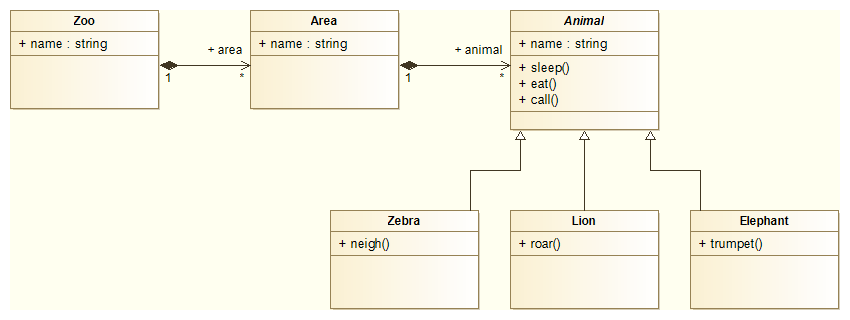Example queries on XMI models¶
These are some sample queries that can be done on any set of indexed XMI-based UML models, assuming that Class::name has been added as an indexed attribute and Class::ownedOperationCount has been defined as a derived attribute (as showed in the core concepts page). All the queries are written in the Epsilon Object Language.
In order to index XMI-based UML models, you only need to enable the UMLMetaModelResourceFactory and UMLModelResourceFactory plugins when you create a new Hawk instance, and ensure your files have the .uml extension. If you are using any predefined UML data types, you may also want to add a PredefinedUMLLibraries location inside "Indexed Locations": that will integrate those predefined objects into the Hawk graph, allowing you to reference them on queries.
The rest of this article will run on this toy XMI-based UML file, which was exported from this Modelio 3.2.1 project:

To avoid ambiguity in type names, the default namespaces list in the query dialog should include the UML metamodel URI (http://www.eclipse.org/uml2/5.0.0/UML for the above UML.ecore file).
All instances of a type¶
return Class.all.size;
Returns the total number of classes within the specified scope. If you leave "Context Files" empty, it'll count all the classes in all the projects. If you put "*OSS.modelio.zip" in "Context Files", it'll count only the classes within the OSS project. This is faster than going through the model because we can go to the Class node and then simply count all the incoming edges with label "ofType".
You should obtain this result:
6
Reference slots in a type¶
return Model.types.selectOne(t|t.name='Class').references;
Gives you all the reference slots in the UML "Class" type. This is an example of the queries that can be performed at the "meta" level: more details are available in [[Meta level queries in Hawk]]. The result would look like this:
[Slot [typeNode=...], Slot [...], ...]
Reference traversal¶
return Class.all
.select(c|c.qualifiedName='zoo::Zebra')
.superClass.flatten.name;
Gives you the names of all the superclasses of class Zebra within model zoo:
[Animal]
Reverse reference traversal¶
return Class.all
.select(c|c.qualifiedName='zoo::Animal')
.revRefNav_superClass.flatten.name;
Gives the names of all the subclasses of Animal (follows "superClass" in reverse). The UML metamodel doesn't have "subclass" links, but we can use Hawk's automatic support for reverse traversal of references. In general, if x.e is a reference, we can follow it in reverse with x.revRefNav_e. We can also access containers using x.eContainer.
Result:
[Elephant, Zebra, Lion]
Range queries with indexed or derived integer attributes¶
return Class.all.select(c|c.ownedOperationCount > 0).name;
Finds the names of the classes with at least one operation of their own.
Result:
[Lion, Animal, Elephant, Zebra]
Advanced example: loops, variables and custom operations¶
var counts = Sequence {};
var i = 0;
var n = count(0);
while (n > 0) {
counts.add(Sequence {"> " + i, n});
i = i + 1;
n = count(i);
}
return counts;
operation count(n) {
return Class.all.select(c|c.ownedOperationCount > n).size;
}
This query produces a sequence of >x, y pairs which indicate that y classes have more than x operations of their own.
Result:
[[> 0, 4], [> 1, 1], [> 2, 1]]